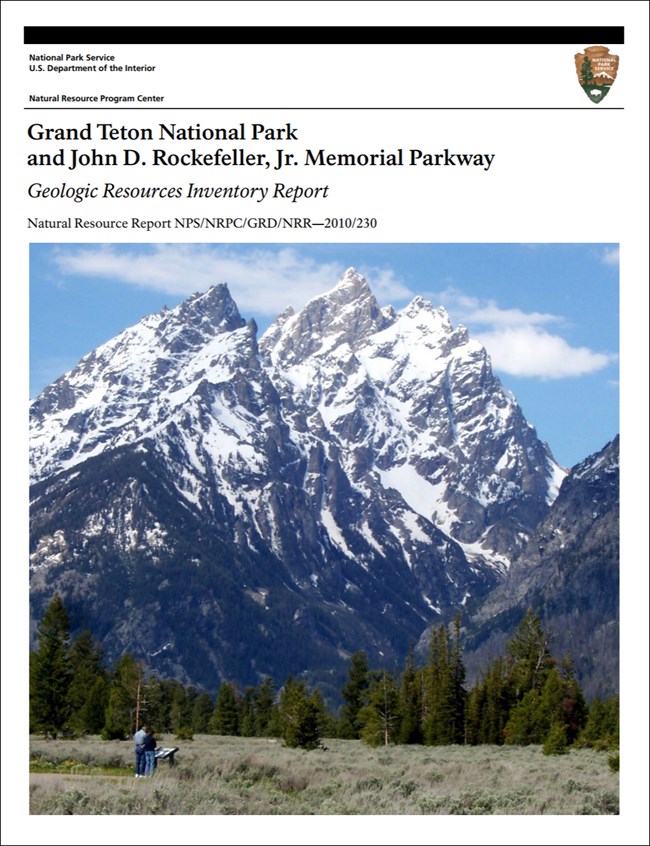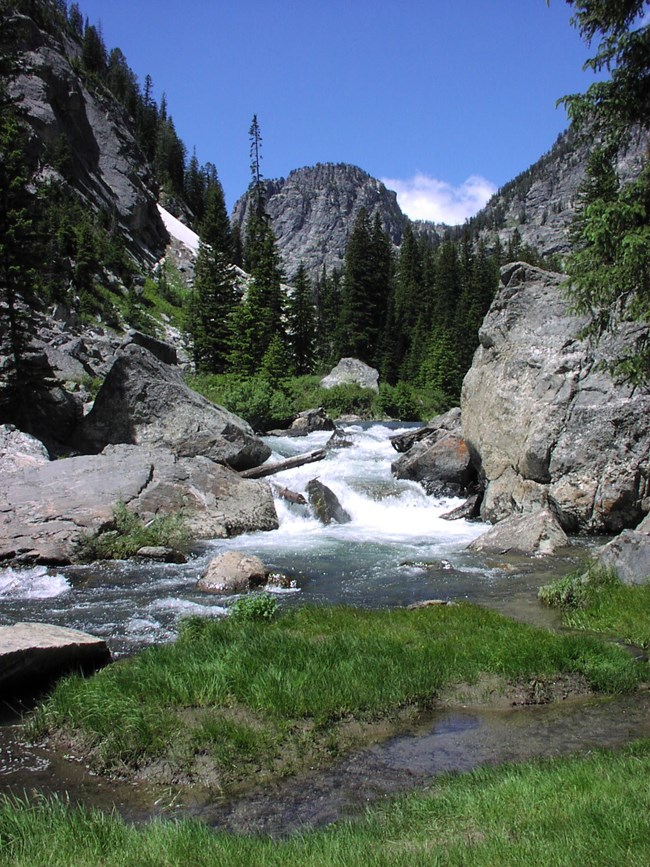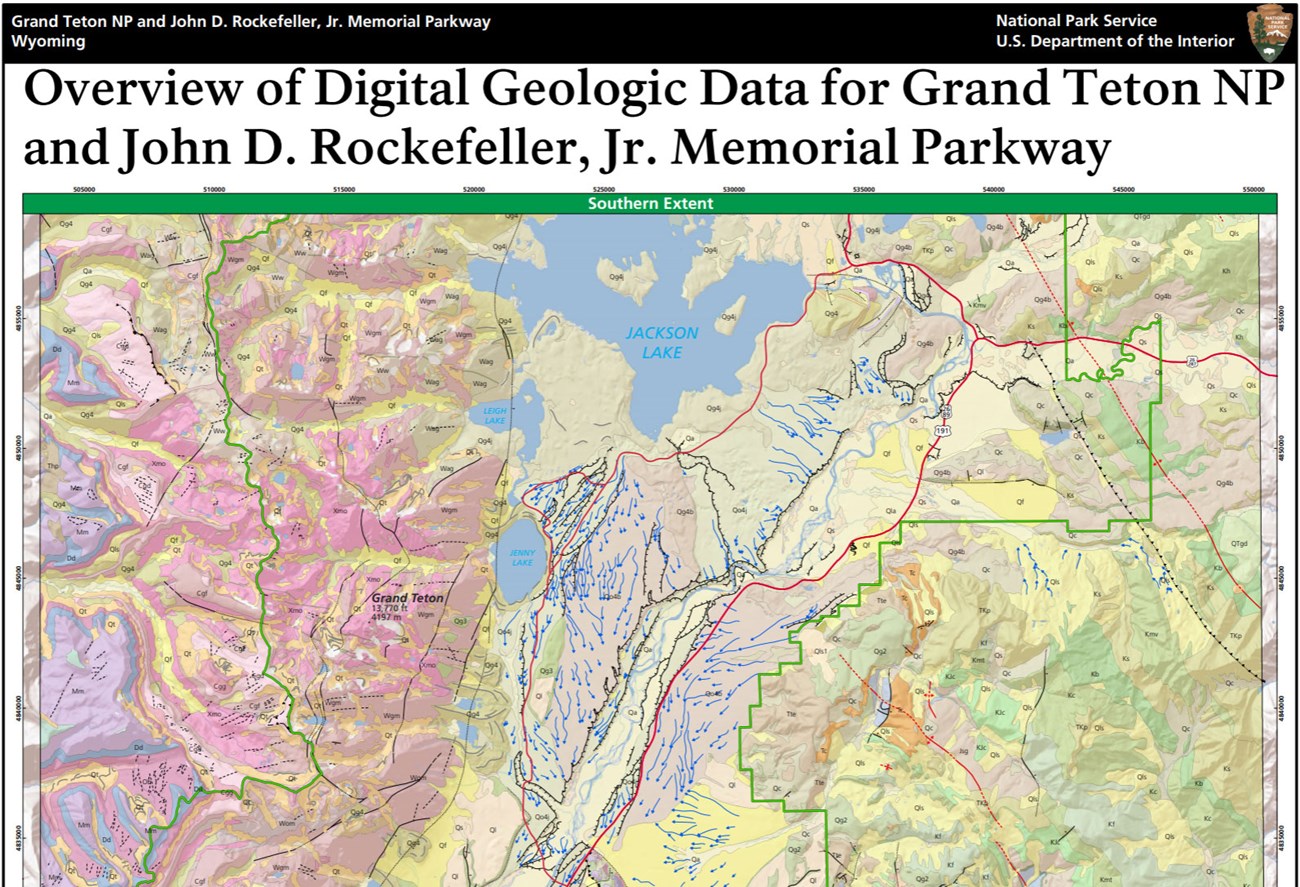Last updated: September 10, 2024
Article
NPS Geodiversity Atlas—Grand Teton National Park, Wyoming
Geodiversity refers to the full variety of natural geologic (rocks, minerals, sediments, fossils, landforms, and physical processes) and soil resources and processes that occur in the park. A product of the Geologic Resources Inventory, the NPS Geodiversity Atlas delivers information in support of education, Geoconservation, and integrated management of living (biotic) and non-living (abiotic) components of the ecosystem.

Introduction
Grand Teton National Park (GRTE), located in Teton County, Wyoming, was established on February 26, 1929 and features the rugged, iconic peaks of the Teton Range, the expansive valley of Jackson Hole, and the scenic Snake River. Congress enlarged the boundaries of GRTE on September 14, 1950 to incorporate much of the Jackson Hole National Monument, increasing the park area to 125,270 hectares (310,044 acres) (Anderson 2017). Located in northwestern Wyoming, the park is situated within one of the world’s largest intact temperate ecosystem that is home to diverse wildlife, including grizzly bears, wolves, bison, moose and elk (Anderson 2017). For centuries the Teton Range has served as an important landmark for Native Americans, trappers, prospectors, explorers, scientists, and tourists. Today, more than 2 million visitors come to the park annually to experience its spectacular landscape.
Geologic Setting
The dramatic landscape of GRTE has been sculpted by dynamic geologic processes to create a variety of geothermal, glacial, and volcanic features in addition to Snake River terrace deposits. The spectacular topography and scenery of the Teton Range is the result of plate tectonics and the active Teton fault, a normal fault extending more than 70 km (40 mi) from north to south along the eastern base of the range (KellerLynn 2010). Tectonic forces along the Teton fault have raised the Teton Range and dropped Jackson Hole to create more than 2,100 m (6,900 ft) of topographic relief. Exposed rock units in GRTE represent a vast range in age from Archean (4.0–2.5 billion years ago) (see The Precambrian) to Quaternary (2.6 million years ago–Present) (see Cenozoic Era). The Teton Range consists of an uplifted core of igneous and metamorphic Archean and Proterozoic rocks surrounded by Paleozoic and Mesozoic sedimentary rocks. Younger Cenozoic deposits dominate the land surface immediately east of the core in Jackson Hole.Geologic Features and Processes
The central feature of the park is the Teton Range, an active, faultblock mountain front that is 40 miles long and 7–9 miles wide. The range includes 12 peaks over 12,000 feet, with the highest in the range over 13,000 feet. The park protects 7 morainal lakes along the base of the Teton Range and more than 100 alpine and backcountry lakes. The Snake River bisects the valley of Jackson Hole and is the headwaters of the Columbia River system.
The oldest rocks in Grand Teton National Park are also some of the oldest rocks in the National Park System and the world. These rocks represent Archean (4.0 billion to 2.5 billion years old) crust, part of the North American protocontinent. The Archean suite is composed of gneiss, amphibolites, ultramafic rocks, and metagabbro. Paleozoic and Mesozoic sedimentary rocks surround the central core, excepting the Cenozoic deposits that dominate the land surface immediately east of the core, in Jackson Hole.
Regional Geology
Grand Teton National Park is a part of the Middle Rocky Mountains Physiographic Province and shares its geologic history and some characteristic geologic formations with a region that extends well beyond park boundaries.
- Scoping summaries are records of scoping meetings where NPS staff and local geologists determined the park’s geologic mapping plan and what content should be included in the report.
- Digital geologic maps include files for viewing in GIS software, a guide to using the data, and a document with ancillary map information. Newer products also include data viewable in Google Earth and online map services.
- Reports use the maps to discuss the park’s setting and significance, notable geologic features and processes, geologic resource management issues, and geologic history.
- Posters are a static view of the GIS data in PDF format. Newer posters include aerial imagery or shaded relief and other park information. They are also included with the reports.
- Projects list basic information about the program and all products available for a park.
Source: NPS DataStore Saved Search 2885. To search for additional information, visit the NPS DataStore.
A NPS Soil Resources Inventory project has been completed for Grand Teton National Park and can be found on the NPS Data Store.
Source: NPS DataStore Saved Search 2956. To search for additional information, visit the NPS DataStore.

Related Links

